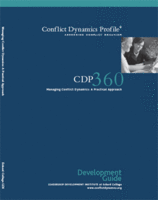Turning Conflict Into Career SuccessWritten on the 15 August 2008 by Marji McClure ) As a leader, your success or failure is determined by what you get accomplished during your tenure. Sometimes, the wins come easily. Other times, they can be hard-fought battles. No matter where one looks, in the workplace or not, conflict is certainly prevalent. Because people have different and diverse backgrounds — and thus, different ideas and opinions — conflict in both personal and professional lives is inevitable. It can also be quite uncomfortable. As a result, for most people, the natural response is to avoid conflict. In the workplace, many executives echo that response. In nearly 30 years of research and working with clients, Judith Glaser has found that there are two skill sets that are least developed in human beings: handling difficult conversations (conversations that involve conflict) and asking “what if ” questions (questions that transition individuals from conflict into innovative solutions.) “What we’ve seen is that people avoid talking about conflict issues, especially those that put relationships in jeopardy, create embarrassment, cause arguments and fights, and end in win/lose,” explains Glaser, CEO of New York City-based Benchmark Communications. “To many people, conflict means ‘disagreements that are unsolvable.’ That is, if they even believe they’re facing a conflict. “Oftentimes, the executive won’t even view a particular situation as a conflict when, in fact, it may be,” says Stephen Xavier, CEO of Westlake Village, Calif.-based Cornerstone Executive Development Group. “In their eyes, it may be as simple as a need to influence a decision or as dramatic as a flat-out ‘fight to the death’ with a peer or other individual for a shot at much-needed resources, a need for others to see a very different point-of-view on visions, strategy or direction. ”Yet, most of the time, it is conflict that executives are faced with. In a collaborative environment where many ideas are generated and processes are created, conflict will exist. “In organizations that place a high value on innovation and creativity, conflict is bound to occur,” says Tim Flanagan, co-author with Craig Runde of Becoming a Conflict Competent Leader and Building Conflict Competent Teams. “In some ways, it’s not just inevitable, but necessary. Executives don’t want people who think alike; they need people who think differently. When people think differently, innovations arise. So does conflict.” If you’re going to be able to exploit those innovations and make your entire organization successful, you need to be able to deal with the conflict that most often accompanies those great ideas. Plus, the conflict itself can spark new ideas, and executives must be able to recognize those opportunities when they emerge. “What executives do know for sure is that conflict management is difficult,” says Jim Ramerman, co-CEO of McArdle Ramerman Inc., an executive leadership development firm based in Rochester, NY. “They know that specific conflicts need to be resolved in order to get things done and to move forward. A smaller percentage realize how rare a skill conflict management is and how it can be a career differentiator that separates them from others. Many find out too late that an unmanaged conflict can possibly spin out of control and damage an entire organization and possibly even their own career with it.” Oftentimes, executives don’t recognize that strong conflict management skills are among the most important leadership capabilities they can have. “Unfortunately, according to our research, the ability to manage conflict is one of the important leadership competencies that are in the shortest supply and the most difficult to develop,” says Patrick Costello, client partner with Minneapolis based LeaderSource, a Korn/Ferry company. One reason that it is so difficult to develop is that conflict management encompasses a variety of leadership capabilities. “It is a ‘metaskill’ made up of a number of different competencies along with emotional intelligence: self-awareness; empathy; listening skills; composure; ability to read others; building effective teams; and the ability to take the heat,” explains Costello. Changing Your Outlook Experts agree that the next step is to accept that conflict exists. “This requires self-awareness, as sometimes the core conflict is internal within the executive,” adds Dominguez. “Self-awareness allows the executive to clearly and objectively identify the conflict and resolve it (or empower others to resolve it) in the most appropriate way.” Leaders need to also be able to identify conflict quickly. “Executives need the ability to get a sense of the contours of the conflict as it is unfolding,” says Holly Weeks, author of Failure to Communicate: How Conversations Go Wrong and What You Can Do to Right Them. “They need to know their own strengths and weaknesses in dealing with conflict in order to build on the first and offset the second. Most need to get beyond their old habits and develop a repertoire of responses to what is likely to come up in a conflict conversation.” Runde, director of new program development at The Leadership Development Institute (LDI) in St. Petersburg, Florida says he and Flanagan use a “Conflict Dynamics Profile” assessment instrument as one way in which to develop this self-awareness. Flanagan is director of custom programs at LDI.)
When Mediation is Necessary Delida Costin, a business attorney in Oakland, Calif., says that lawyers can be especially helpful in various situations, such as when companies “are putting Career Success a deal together and they don’t know how to get from point A to point B,” Costin explains. Attorneys listen to both sides and help put solutions in place. Mediators can also help companies and their executives work through conflict. Costin, recognizing that need, has added mediation to her practice. She notes how as an attorney, she serves as an advocate for her clients; as a mediator, her role is to remain neutral and help both parties reach a resolution. One example of a conflict that requires a mediator, Costin explains, is when two employees are not getting along “and the company is worried about issues escalating into a lawsuit, or the company values both employees and wants them to stay and work together,” says Costin. After the mediator helps resolve the conflict, he or she continues to follow-up to see if the issues remain resolved.
“When executives enable open, honest, robust debate, previously unimaginable suggestions and solutions become possible,” says Flanagan. “Participants in such discussions stay focused on the substance of the ideas instead of the distractions related to criticism, blame or cynicism.” Teams are then more convinced that a resolution in which everyone is comfortable can be reached. “Leaders have an opportunity to set a positive example when it comes to handling conflict by addressing it with a positive and welcoming attitude, as well as working to resolve it with an open and ‘win/win’ outcome in mind, where possible,” adds Chang. “With the appropriate skills, leaders can build upon the opportunities that this diversity provides for the greater good of the teams and organizations they lead.”
Dr. Marcia Reynolds says that if an executive can create an organization that is self-managed, groups can create their own guidelines for working together, thus enabling them to resolve their own conflicts instead of turning to their leader to do so. “If this is the case, then good training and coaching on conflict management/emotional intelligence skills should be provided for everyone so there is a common language and way of being with each other throughout the organization,” adds Reynolds. Ramerman says that the best leaders study conflicts and develop a consistent approach to dealing with them, such as: • Remember that change and effective conflict management begins with self. Creating such a conflict competent culture should be the ultimate goal for executives. “A leader has remarkable power to model and create a culture of respect in an organization: self-respect characterized by people who can hold their own, but also own what they do, and respect for counterparts characterized by the idea that ‘We’re two human beings who are not now in accord — we’re in this together’ instead of a win-or-lose battle for control,” says Weeks. “Such a culture doesn’t ignore or undermine power differences but, in managing conflict where reputations, relationships and viable outcomes are at stake, power moves to the background, and respect comes to the foreground.” Xavier advises leaders to encourage colleagues to keep critical issues in the forefront for discussion. “Discourage ‘side-bars’ and water cooler talk on key issues,” says Xavier. “Tough issues never get resolved when discussed to the exclusion of the party affected.” Runde says that he and Flanagan have spoken with many leaders who said that they would have preferred to have learned conflict management skills earlier in their careers. “They routinely say they would have been more successful and have risen higher if they had known how to deal with conflict,” says Runde. “From an organizational effectiveness standpoint, we strongly believe that organizations won’t deal effectively with conflict unless the leaders develop their personal conflict competence and champion organization-wide competence Expert Resources: What to Become a Conflict Competent Leader? Ask us how Author:Marji McClure |



 The Training Component
The Training Component


